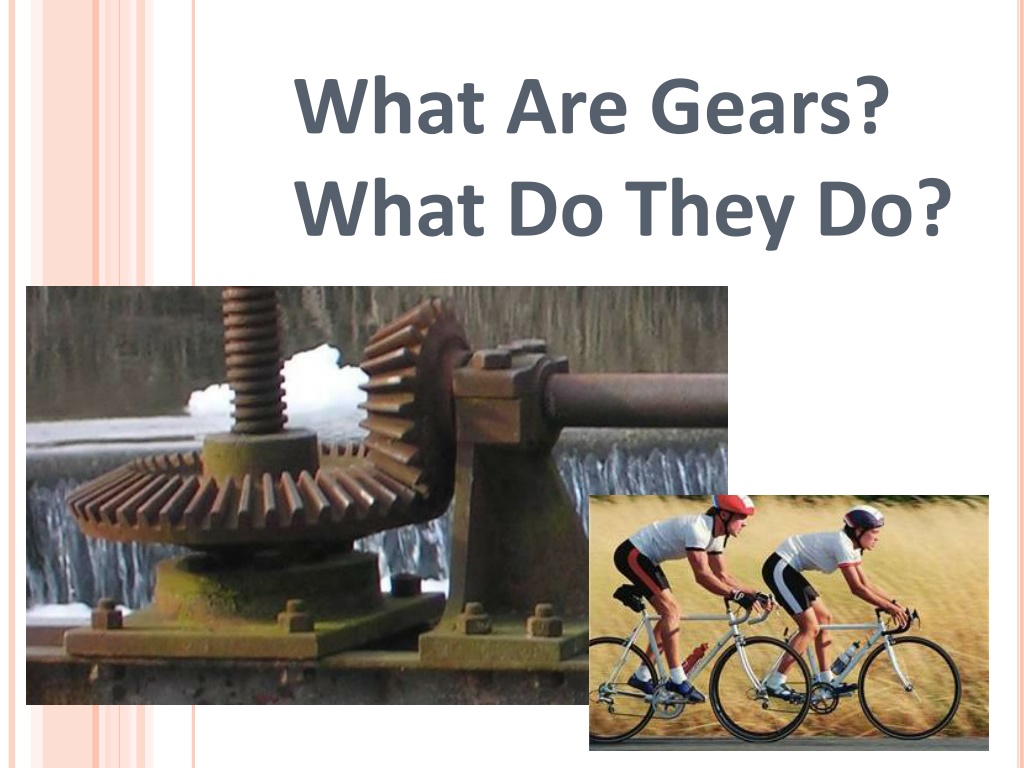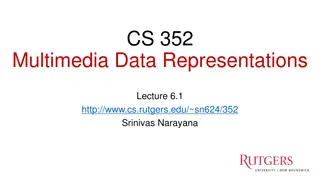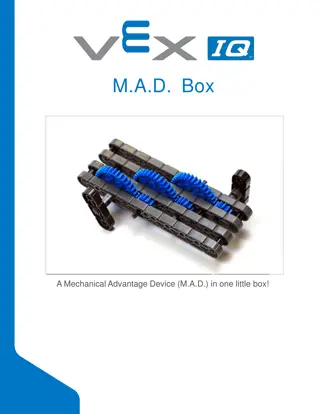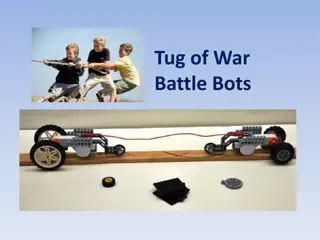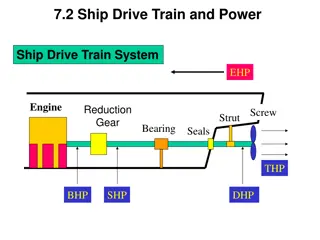Understanding Gears and Their Applications
Gears are wheels with teeth that mesh to change speed, direction, and torque in machines. This lesson explores the diverse types of gears, their functions, and real-world examples like in bicycles and clocks. The interactive pre-lesson quiz and engaging activities further enhance understanding of gear mechanisms.
Download Presentation

Please find below an Image/Link to download the presentation.
The content on the website is provided AS IS for your information and personal use only. It may not be sold, licensed, or shared on other websites without obtaining consent from the author. Download presentation by click this link. If you encounter any issues during the download, it is possible that the publisher has removed the file from their server.
E N D
Presentation Transcript
What Are Gears? What Do They Do?
Pre-Lesson Quiz 1. What is a gear? 2. List as many examples as you can of gears or objects that use gears. 2
Pre-Lesson Quiz Answers 1. What is a gear? A gear is a wheel with teeth that meshes together with other gears and is usually made of metal or plastic. 2. List as many examples as you can of gears or objects that use gears. Examples: wind-up toys, non-digital clocks, drills, bicycles, car transmissions, powered wheel chairs, and lifts. 3
What Are Gears? What Do They Do? 50 minutes Gears are used all around us and are relevant to understanding of how machines work. Do you recall seeing gears on your bike? Do you know how the bike gears work to move the bike forward? Today s lesson will help you understand how gears are used in machines such as clocks, cars and even bulldozers! We will consider several types of gears. Then, we will apply ideas about gearing in the next class to two design challenges: 1) Hare Challenge and 2) Snail Challenge 4
What Is a Gear? A gear is a wheel with teeth that meshes with another similar gear that is typically larger or smaller. Gears come in various sizes and types. Depending on the situation, one gear may work better than another. Gears are used to change the speed, torque and direction of a power source. What is a gear used for? Changing speed Changing direction of motion Changing torque 5
Introduction to Gears Watch this excellent 11-minute video: Gear Basics https://www.youtube.com/watch?v=odpsm3ybPsA Topics covered: Spur gears with axles Using gears to change direction of rotation Using gears to change rate of rotation Compare rates of rotation by comparing number of teeth Compound gears and bevel gears Mechanical advantage (using gears to change force) Canal or river locks (using hand-operated wenches) Bicycles (gears connected by chains = sprockets) 6
Different Types of Gears worm gears spur gears bevel gears pulleys 7
Most Common Gear: Spur Gears Mini-activity: Assemble the gears as shown below. Use the axle to turn the small gear by hand. Question: If X turns of the small gear causes 1 turn of the large gear, what is X? Materials List: 1/16 beam two #6 axles (put bushing on back side) 8-tooth gear 40-tooth gear In this case, the GEAR RATIO is defined as 1:X (output: input). Notice that this is the same ratio as the number of teeth, that is, 8:40 or 1:5. 8
What Are Idler Gears? Mini-activity continued Next, add a third gear in the middle. To do this, move the small gear left. Now turn the small 8-tooth gear (at left) and see how the 40-tooth gear (on the right) turns. Does the turn ratio change or stay the same? No difference! No matter what gear you put in the middle, the gear ratio between the left and right gears does not change! That is why the gear in the middle is called the idler gear; it does not change the gear ratio at all! 9 The idler makes both the input and output gears rotate in the same direction, and helps add distance between the gears.
Gear Ratio: Effect on Speed and Torque Worksheet Questions 1. Imagine two 40-tooth gear contacting each other. When one 40-tooth gear turns once, how many times will the other 40- tooth gear turn? 2. Now, imagine replacing one of the 40- tooth gears with an 8-tooth gear, with the 40-tooth gear turning the 8-tooth gear. When the 40-tooth gear turns once, how many times will the 8-tooth gear turn? 10
Gear Ratio: Effect on Speed and Torque Worksheet Answers Imagine two 40-tooth gear contacting each other. When one 40-tooth gear turns once, how many times will the other 40- tooth gear turn? Answer = 1 1. Now, imagine replacing one of the 40-tooth gears with an 8- tooth gear, with the 40-tooth gear turning the 8-tooth gear. When the 40-tooth gear turns once, how many times will the 8-tooth gear turn? Answer = 5 2. If the 8-tooth turns the 40-tooth gear (as you will learn later in physics), the 40-tooth gear s axle will have 5 times the torque (rotational force) than the 8-tooth gear s axle. So, although the large gear turns slowly, it can push more! 11
What Is Torque? Why Is It Important? Think of torque as a rotational force, that is, a force that causes rotation and not forward movement. For the same motor power setting, more torque in a machine (such as a bicycle or car) leads to lower speeds, and less torque leads to higher speeds. This is because power = torque * speed. When we increase speed from the input to the output gear, we decrease torque by the same amount! So, in any design you develop, you must decide which is more important: speed or torque, or maybe both... and then select the appropriate gear ratio! 12
What Are Worm Gears? Look at this description and animation of a worm gear at http://en.wikipedia.org/wiki/Worm_drive Watch its application in this 2-minute video, Worm Gear Speed Reducer at http://www.youtube.com/watch?v=S3XAeMCeZr0 Worm gears transmit rotations in perpendicular directions, that is, their axles are perpendicular, like bevel gears. Worm gears act like gears with one tooth and thus can provide very large gear ratios. You can transmit rotation one way, from the worm gear to the spur gear, but not the other way. Thus, worm gears can be used as locking mechanisms. 13
Belts and Pulleys Belt and pulley combinations look like gears! They have speed ratios like gears, but they are ratios of diameters. Belts and pulleys can transmit motion across long distances. But, both pulleys rotate in the same direction (the opposite of two gears). 14
Post-Lesson Quiz 1. What is a gear? 2. How do we select the gear ratio for a particular application? 15
Post-Lesson Quiz Answers What is a gear? A gear is a wheel with teeth that meshes together with other gears. It is usually made of metal or plastic. How do we select the gear ratio for a particular application? Some applications (machines) may need to be fast, while other machines may need to be strong. When designing gears for a machine, it is important to know whether speed or torque (strength) is more important. Remember that power = torque x speed, so, if the EV3 motor power setting is kept fixed, then increasing the torque decreases speed, and vice versa. In general, if you need to have more torque, select a larger gear ratio. If you need to move fast, then use a smaller gear ratio. 1. 2. 16
Vocabulary design: Loosely stated, the art of creating something that does not exist. gear: A rotating machine part with cut teeth that mesh with another toothed part in order to transmit torque; usually, the teeth on both gears are identical in shape. pulley: A wheel on an axle that is designed to support movement and change in direction via a cable/belt/chain along its circumference. torque: The tendency of a force to rotate an object about its axis or pivot. 17
